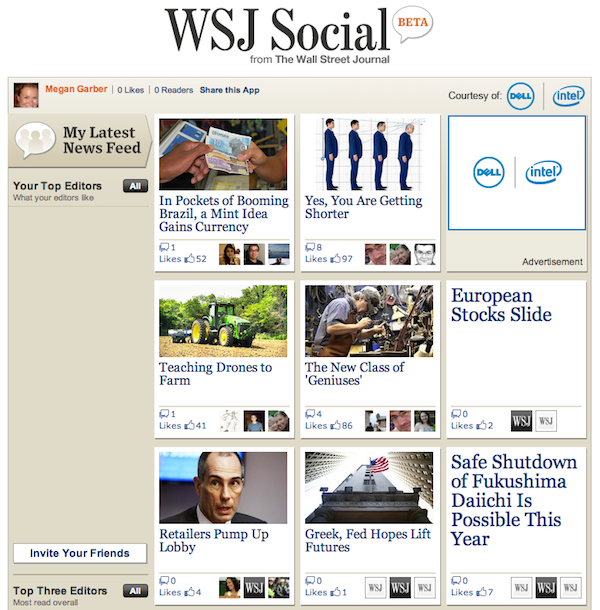
The most recent stats could be, for news outfits, pretty grim: Americans spend 22.5 percent of their time online visiting social networks and blogs, and only 2.6 percent of their time learning about current events. And among the social sites, of course, none is more time-consuming than Facebook: In May alone, the site sucked up over 53 billion minutes of Americans’ time.
For media organizations, the takeaway is clear: “You can’t rely on users coming to you anymore,” says Maya Baratz, head of new products at the Wall Street Journal. With that in mind, today the Journal is launching a product that, it’s betting, will allow it to come to its users: WSJ Social, a Facebook application. Within the app, users have the ability to subscribe to different streams of content, curated both by fellow users and by the paper itself. (All Journal content that’s shared — or Liked — by a user within the app will also be pushed to that user’s main Facebook profile newsfeed.) The app creates, essentially, a publication that is personalized by way of selective social curation.
With WSJ Social, the Journal is purposely “navigating the content within the app around people,” Baratz told me, and making “every user an editor”; the app, in large part, she says, is about “elevating the role of people as curators of content.” The end result: “When you walk into the app, you have this very curated publication,” Baratz says — one that could, if done right, provide users with a nice mix of personalization and serendipity.
There’s a competitive element to the app, as well. WSJ Social ranks each of the app’s user-editors on a leaderboard according to the number of people that have added those editors to their editor lists. The plan is to reward top editors over time — the reward after the first month being, potentially, a WSJ stipple portrait of the winners. “We really want to show that it’s not a game,” Baratz says. “We really think that these people are curators,” doing important distributive work that, at scale, could prove immensely valuable to the WSJ — and prizes are meant to acknowledge that.
And…what about the Journal’s paywall? While premium content on WSJ.com will remain premium in its Facebook app, the Journal has made a sponsorship arrangement with Dell that will keep app content free for users for the first month of WSJ Social’s existence. (So far, that’s the only deal that’s been brokered — but it’s easy to see, if the app proves popular, other companies taking advantage of the sponsorship opportunity and keeping the app’s content free for all on a month-by-month basis.) And the Journal will keep all the revenue from ads that appear within the app.
Baratz, under Daniel Bernard, the Journal’s chief product officer, and Alisa Bowen, general manager of the Wall Street Journal Digital Network, has been working on the project for the past three months, she told me — and has been conceiving of it in theory for even longer than that. “For a media company to survive in this type of web economy,” she wrote in a 2010 HuffPo post, while still a product manager at MTV Networks, “it’s becoming increasingly clear that it needs to play the role of an app or a platform.” The takeaway: “Rather than trying to control its profits by curtailing the spread of its content, the news industry should be redefining a means to fuel that profit off of such a spread.”
For the journal, WSJ Social is one step toward that redefinition. While partnering with Facebook can be a controversial move for news organizations — as Forbes’ Jeff Bercovici pointed out, the app also serves the interests of Facebook itself, “which sees content as a way to bring people to the site and keep them there, interacting with each other, buying stuff and getting served ads” — the Facebook team-up is a big move for a newspaper that’s built one of the most high-walled walled gardens out there. (The fact that the app’s officially in beta, too, is telling of the paper’s move toward openness, in every sense.) It’s a way of disentangling the Journal’s brand from its website — and of building a distribution strategy around the most famous anonymous quote in the future-of-news world: “If the news is that important, it will find me.”